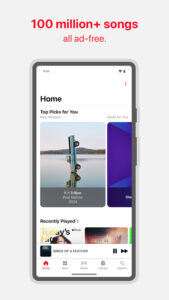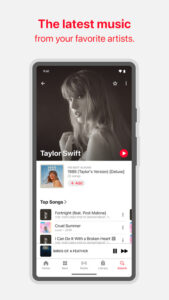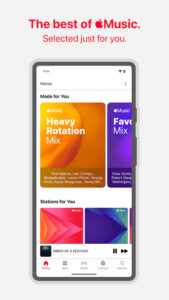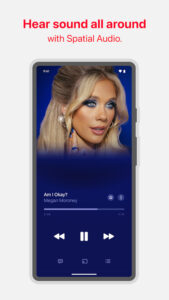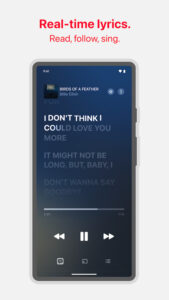Apple Music
Apple
Nov 10, 2015
September 16, 2025
157 MB
5.1.0-beta
Android
100,000,000+
Description
Discovering Apple Music on Android: A Premium Music Streaming Experience
Apple Music apk is a music streaming application for Android that enables users to access a vast catalog of tracks, albums, and playlists directly on their mobile devices. If you’ve ever wondered whether the polished music experience Apple delivers on its own devices primarily iOS can transfer to Android, you’re not alone I was skeptical, too. After spending weeks exploring its features and quirks, I can say the app brings a surprising level of depth, control, and audio quality, often exceeding expectations, and sometimes throwing in a few curveballs. This article unpacks Apple Music on Android how it works, where it excels, what to expect, and why both audiophiles and casual listeners might find a new daily soundtrack companion.
Apple Music Playlists and Library Management: Key Features on Android
Extensive Music Library and Personalization
Apple Music sets itself apart with a gigantic music library over 100 million tracks ready to stream or save offline. For everyday playlists or lost classics, variety isn’t a problem. You get curated “For You” sections, daily mixes, and radio stations that update as your tastes evolve.
- “Love” or “Dislike” buttons help the app hone your preferences, reshaping your recommendations within days of active use.
- New releases and editor-curated moments give you a reason to check back frequently.
- Discovery tools like genre-based radio stations keep surprises coming, though some niche genres might be less well-covered.
In practice, users report that daily mixes and personalized playlists often align better with their current tastes than similar offerings from Spotify or YouTube Music. I found myself revisiting old favorites and stumbling onto fresh tracks with minimal effort. The “Listen Now” and “Browse” tabs simplify the journey between mainstream hits and hidden gems, all in a few clicks.
Library Management and Playback Controls
Managing a growing music collection can become chaotic, fast. Apple Music’s approach turns this process into a smooth ride with powerful library management tools.
- Playlist creation and editing are intuitive tap, hold, and drag your way to the perfect mix.
- Album and song removal are just a swipe away, though users sometimes report accidental deletes after rapid changes.
- Smart Playlists use your listening habits to auto-update, grouping new releases or mood-based tracks.
Playback controls stay upfront and simple:
- Full-screen artwork gives a visually rich experience during play.
- Crossfade and gapless playback mean your workouts and commutes stay seamless no awkward silences or abrupt stops.
- For perfectionists, “Up Next” allows quick queue reshuffling, whether you’re prepping for a party or just jumping between moods.
User feedback highlights the balance. Many appreciate the clean, responsive scrolling. Others note rare duplicate songs appearing after app updates a minor annoyance, but one easily fixed with a quick library scan.
Exploring Lossless Audio and Dolby Atmos: Apple Music’s Sound Innovations on Android
Lossless, Hi-Res, and Spatial Audio Support
Apple Music distinguishes itself with serious attention to sound quality, catering to both casual listeners and audio enthusiasts. Lossless Audio streams reach up to 24-bit/192kHz a treat for listeners with high-end headphones.
- LDAC support pushes wireless Bluetooth quality on compatible devices, especially on Sony models and certain Android phones.
- Dolby Atmos-powered Spatial Audio adds depth, creating a 3D audio effect that brings live performances and immersive tracks to life.
During testing, these options produced clear differences. Classical, jazz, and live recordings shine brightest; I noticed subtle details strings, crowd cheer, reverb that standard streaming often mutes. Audiophiles moving from Spotify or YouTube Music remark on the “night and day” improvement, though your smartphone and headphones will determine just how much difference you hear.
A quirk worth noting: transitions between audio formats aren’t always buttery smooth. Flipping modes mid-playlist can temporarily dip audio quality before stabilizing.
Optimization Tips and Settings
Get the most from Apple Music’s sound by learning a few critical tricks:
- Dive into Settings > Music Quality and enable Lossless Audio for both streaming and downloads (this eats up data and space, so consider your plan).
- For best Bluetooth output, pair with phones and headphones that support LDAC or aptX.
- Activate or disable Dolby Atmos depending on your mood some tracks sound better without added processing.
- Use crossfade in the playback menu for seamless transitions, ideal for background listening. But turn it off for live albums to keep track breaks clean.
- Regularly clear the app cache from Android settings to avoid playback stutters or artwork glitches, especially after big updates.
These adjustments don’t take long but can make all the difference between “pretty good” and “exceptional” listening sessions.
Reliable Offline Playback and Playlists Sync on Apple Music for Android
Reliable Offline Access and Downloads
Offline mode is essential for anyone who commutes, travels, or spends time in areas with spotty Wi-Fi. Apple Music on Android covers this base well most of the time.
- Download individual tracks, whole albums, or entire playlists with a tap.
- Gapless playback ensures your downloaded music plays smoothly, with no interruptions, even on a plane or in remote areas.
- For frequent travelers, bulk download options simplify prepping your device for long trips.
Some users, including myself, have experienced partial download issues where a playlist stops midway or fails to sync fully in weak network areas. A quick retry usually solves the problem, but it can frustrate if you’re in a hurry.
Synchronization Across Devices
Cross-device synchronization forms the backbone of any good music service. With Apple Music, your likes, playlists, and history typically sync between your Android devices phone to tablet, and vice versa.
- Edits and additions update nearly in real-time, mirroring across your Google-linked and Apple-linked devices.
- Smart suggestions adapt as you switch devices, keeping recommendations consistent.
However, isolated reports surface of libraries becoming unsynced, particularly after app crashes or forced logouts:
- Force-closing and restarting the app resolves most incidents.
- In rare cases, a logout might wipe offline downloads, requiring you to re-download everything.
These hiccups are rare but worth keeping an eye on, especially for users who frequently jump between multiple devices.
Seamless Android Navigation: Optimizing Apple Music with Tasker and More
User Interface and Workflow Efficiency
First impressions matter. Apple Music’s user interface gives you a clean, uncluttered dashboard, with well-marked tabs for Library, Search, and radio stations. Gone are the days of squinting at tiny icons or endless pop-up menus.
- The main screen lets you jump straight to recently played tracks or playlists.
- Scrolling lyrics synchronize as music plays a karaoke lover’s dream, though some advanced modes stay exclusive to iOS and Apple devices.
- “Recently Added” and “Top Picks” sections organize discoveries without digging.
I appreciated the buttery navigation on Android it felt smoother than some other apps I’ve tested, even after a week-long, playlist-heavy session. Quick volume and song-skip gestures mesh well with Android Auto, making in-car listening safe and responsive.
Troubleshooting and Optimization Strategies
Even the best apps have off days. Apple Music’s most common issues fall into a few buckets, with user workarounds widely shared online:
- Buffering problems when switching networks? Clearing the cache or restarting the app usually helps.
- App logs you out every few months? It’s a nuisance, but cloud data ensures you can restore playlists after logging back in.
- Playback stuttering after updates? Reinstalling the app while preserving library data almost always fixes it.
- Gaps in offline downloads or random track removals? Check your network stability and retry downloading; switching to a stronger Wi-Fi can rescue stuck downloads.
- Rooted Android devices sometimes get blocked from the app, though techniques using Magisk Hide have been reported to bypass these restrictions (use at your own risk).
Small optimizations can transform your daily experience:
- Schedule regular cache clears.
- Backup important playlists online to avoid loss from rare app resets.
- Integrate with Tasker for automated playlist starts handy for workouts and routines.
Apple Music, Chromecast, and Android Auto: Platform Compatibility & Subscription Value
Device Compatibility and Ecosystem Benefits
Apple Music’s Android app plays surprisingly well with the larger ecosystem:
- Chromecast and Sonos compatibility let you stream music effortlessly to home speakers.
- Google Assistant integration provides basic voice control; ask to play an album or playlist hands-free.
- Android Auto support means seamless transitions for road trips or commutes.
- Most Bluetooth headphones work, but for peak quality, devices with LDAC or aptX offer better wireless sound.
Comparison Table: Platform Strengths
| Feature | Android Strength | iOS Advantage | Spotify Edge |
| Speed/Responsiveness | Snappier interface | Seamless system ties | Fast cloud search |
| Audio Features | LDAC, Dolby Atmos, Spatial Audio | Bit-perfect USB, video | Optional HiFi tier |
| Ecosystem Fit | Google/Android Auto | AirPlay, Siri | Deep Connect controls |
| Bug Frequency | Occasional buffers | Fewer logouts | Some ad intrusions |
Not everything is perfect. Some older TVs struggle with casting, and Bluetooth on entry-level earbuds can drop out, especially on lossless settings. Still, the overall ecosystem fit on Android is stronger than many newcomers expect.
Subscription Plans and Long-Term Value
Apple Music’s pricing sits at $10.99/month for standard plans, with family bundles that bring down per-user costs for households. Occasional three-month free trials make it easy to test drive before committing.
- Core features high-quality, ad-free streaming, playlist sharing, offline downloads are included without hidden paywalls.
- Lossless and Dolby Atmos streaming don’t cost extra, though you may need a robust data plan to make the most of them.
- Some users value bundling with Apple One for bonus perks like Apple TV+, increasing value for those already in the Apple ecosystem.
User feedback on value is mixed but leans positive, especially among listeners who prioritize audio quality over podcasts or audiobooks:
- “The jump in clarity is worth the price alone for my commute,” one user shared in a review.
- Others note that missing collaborative playlists or real-time edits (like Spotify’s Jam) can be a drawback for highly social listeners.
Refunds and support queries tend to be handled quickly, minimizing frustration around billing or subscription changes.
Why Apple Music is an Ideal Choice for Android Audiophiles and Playlist Fans
Apple Music apk offers Android users a polished, surprisingly feature-rich take on mobile streaming, anchoring itself in robust audio quality, intuitive library management, and powerful personalization tools. Whether you’re an audiophile drawn by Lossless Audio and Dolby Atmos tracks, or a busy commuter in need of dependable offline playback, this app stands tall among its competition, including services like Spotify and YouTube Music. Occasional quirks surface sync hiccups, download stalls, or rooted device roadblocks (sometimes overcome with Magisk). Yet, most daily issues have clear fixes, thanks to a vibrant community of users sharing real-world solutions, sometimes with the help of automation apps like Tasker. For those seeking a refined music experience on Android without sacrificing quality or ease of use Apple Music remains a wise, rewarding choice. And if you’re ever caught singing along to a scrolling lyric on public transport, remember: you’re in good company.
Images
